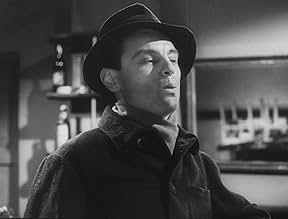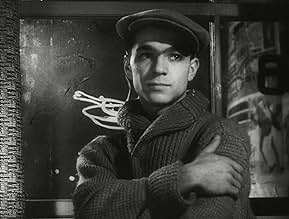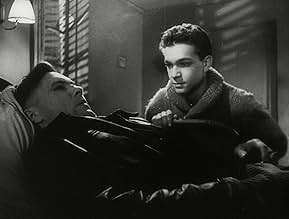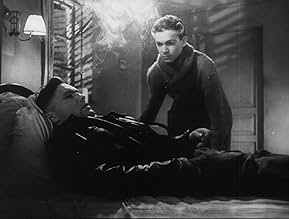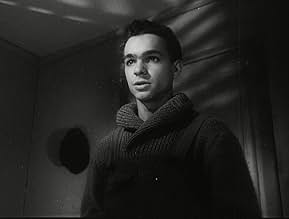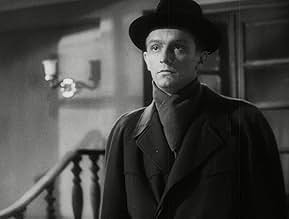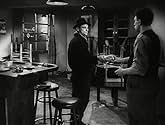AVALIAÇÃO DA IMDb
6,5/10
3,9 mil
SUA AVALIAÇÃO
Adicionar um enredo no seu idiomaTwo men besiege a lunch bar looking for a third man they must kill.Two men besiege a lunch bar looking for a third man they must kill.Two men besiege a lunch bar looking for a third man they must kill.
- Direção
- Roteiristas
- Artistas
- Direção
- Roteiristas
- Elenco e equipe completos
- Produção, bilheteria e muito mais no IMDbPro
Avaliações em destaque
For a class project in a cinema program this isn't bad at all, more of a reenactment of Hemingways's killer short story than a feature film. It takes about as long to watch it as it does to read the original story, with which I assume most of us are familiar.
The images are rather crude, the sets spare, and some of the acting is amateurish, although Aleksandr Gordon as George, the manager, is pretty good. He has the pock-marked sullen face that seems suitable to the role of the ordinary man in a frightening one-down position. The other notable performance is by Vasili Shukshin as Ole Anderson, the resigned victim awaiting his fate in a dumpy rooming house.
The movie follows the written story closely. In print, when Ole is visited by Nick Adams and, halfway through the conversation, rolls over and faces the wall, he does the same on film. We don't see much of Ole's room. I suppose the budget didn't allow for much display. But when Ole stubs out his cigarette on the wall next to his bed, we see that numerous other butts have been stubbed out in the same place and that tells us most of what we need to know.
The directors have made a few changes that don't interfere with the narrative in any way -- bits of business in which one of the killers flicks a few tiny objects off the counter top with his fingertip, that sort of thing.
The only jarring change is the virtual elimination of the role of Sam the black cook. It's too bad because this is in no way a funny story and Sam provides the few light-hearted moments.
No sign of directorial self display. It opens with a POV shot and there are one or two other slight surprises but it's not a Fourth of July fireworks by any means. It's functionally presented.
The English names of the characters is retained and on the café window we see that coffee costs "5 centes." I call it admirable fealty to the source, mistake and all.
What must it have been like, living in a nation in which Ernest Hemingway's work wasn't allowed to be published until 1956? But never mind literature -- can you imagine American movies without ten versions of "Crime and Punishment"? I'm waiting for a Hollywood blockbuster called "The Master and Margarita" starring Jude Law and Angelina Jolie.
The images are rather crude, the sets spare, and some of the acting is amateurish, although Aleksandr Gordon as George, the manager, is pretty good. He has the pock-marked sullen face that seems suitable to the role of the ordinary man in a frightening one-down position. The other notable performance is by Vasili Shukshin as Ole Anderson, the resigned victim awaiting his fate in a dumpy rooming house.
The movie follows the written story closely. In print, when Ole is visited by Nick Adams and, halfway through the conversation, rolls over and faces the wall, he does the same on film. We don't see much of Ole's room. I suppose the budget didn't allow for much display. But when Ole stubs out his cigarette on the wall next to his bed, we see that numerous other butts have been stubbed out in the same place and that tells us most of what we need to know.
The directors have made a few changes that don't interfere with the narrative in any way -- bits of business in which one of the killers flicks a few tiny objects off the counter top with his fingertip, that sort of thing.
The only jarring change is the virtual elimination of the role of Sam the black cook. It's too bad because this is in no way a funny story and Sam provides the few light-hearted moments.
No sign of directorial self display. It opens with a POV shot and there are one or two other slight surprises but it's not a Fourth of July fireworks by any means. It's functionally presented.
The English names of the characters is retained and on the café window we see that coffee costs "5 centes." I call it admirable fealty to the source, mistake and all.
What must it have been like, living in a nation in which Ernest Hemingway's work wasn't allowed to be published until 1956? But never mind literature -- can you imagine American movies without ten versions of "Crime and Punishment"? I'm waiting for a Hollywood blockbuster called "The Master and Margarita" starring Jude Law and Angelina Jolie.
Pure genius, though a short, it sends out images of poetry and passion. Seeing an early stage of formation of majestic artistry will astonish all who sees this film. Rich and powerful, it is an element that sends emotions through all who experience this inspired film.
This short film was a student project for a Soviet state film school, and I don't know how much exposure it would have had at the time it was made. It survives for viewing because one of the three students directors was a young Andrei Tarkovsky, and though his resources were constrained, the strength of the work is made evident through how much is done with a very basic production.
The door out of the restaurant seems to lead to a blank wall, but we nonetheless get the lonely atmosphere of a small-town American diner; the filmmakers really seem to have drank in the feel of the Hemingway they read for this adaptation. It's really a twenty-minute atmosphere piece, and it does that very well - the two murderers create a complete and stark sense of threat and menace.
In a constrained setting they made a claustrophobic and memorable film, with a real film-noir feel where we weren't necessarily expecting to find it. High marks!
The door out of the restaurant seems to lead to a blank wall, but we nonetheless get the lonely atmosphere of a small-town American diner; the filmmakers really seem to have drank in the feel of the Hemingway they read for this adaptation. It's really a twenty-minute atmosphere piece, and it does that very well - the two murderers create a complete and stark sense of threat and menace.
In a constrained setting they made a claustrophobic and memorable film, with a real film-noir feel where we weren't necessarily expecting to find it. High marks!
What the hell is that "Carnival of Colors" on Douban, the director of the 1935 film was Tarkovsky, born in 1932.
Tarkovsky's real nominal debutante is a far cry from the other master's earlier film, The Killer, which seems to have set a different style from the start. But this Tarkovsky without his later that the style of the scene shaping, on the contrary, quite a kind of Hollywood in that era of student work. But the audio-visual does have some aura, especially the fat man on the bed part especially has the style of Tarkovsky's kind of subtle mature dialogues.
The ending and some of the shaping is subtle, but not in Tarkovsky's style. Very strange lag, feels like 16 fps.
Tarkovsky's real nominal debutante is a far cry from the other master's earlier film, The Killer, which seems to have set a different style from the start. But this Tarkovsky without his later that the style of the scene shaping, on the contrary, quite a kind of Hollywood in that era of student work. But the audio-visual does have some aura, especially the fat man on the bed part especially has the style of Tarkovsky's kind of subtle mature dialogues.
The ending and some of the shaping is subtle, but not in Tarkovsky's style. Very strange lag, feels like 16 fps.
I rather like Hemingway's short story which the film is an exact transcription of, but I didn't feel the same things here. In fact, I didn't feel anything. There is, in the way Hemingway's text begins, a playful opacity about who is who, which obviously cannot be found in the film form. Moreover, a large part of the value of the text lies in the laid back, direct, and popular side of the dialogues, difficult to appreciate here if you don't speak Russian, of course. Nothing impressed or bothered me in the filming itself, it's neutral. The acting is very average, but it's hard to expect anything else from a student film.
Você sabia?
- CuriosidadesAll the roles were played by students of the VGIK. Moreover, props were not only brought by students from their homes, but also provided from friends and relatives.
- ConexõesFeatured in Une journée d'Andrei Arsenevitch (1987)
- Trilhas sonorasLullaby of Birdland
Written by George Shearing
(1952)
Whistled by the second bar patron played by Andrei Tarkovsky
Principais escolhas
Faça login para avaliar e ver a lista de recomendações personalizadas
Detalhes
- Tempo de duração19 minutos
- Cor
- Mixagem de som
- Proporção
- 1.37 : 1
Contribua para esta página
Sugerir uma alteração ou adicionar conteúdo ausente

